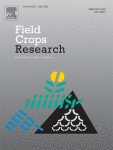Ver ítem
- xmlui.general.dspace_homeCentros Regionales y EEAsCentro Regional Buenos Aires SurEEA Cuenca del SaladoArtículos científicosxmlui.ArtifactBrowser.ItemViewer.trail
- Inicio
- Centros Regionales y EEAs
- Centro Regional Buenos Aires Sur
- EEA Cuenca del Salado
- Artículos científicos
- Ver ítem
Soil water availability and water absorption by maize in sodic soils with high water table
Resumen
Context: Because of the increasing prices of commodities over the last decades, crops like maize (Zea mays L.) are being cultivated in lowland sodic soils with physical-chemical constraints, such as those having natric horizon (Btn); however, the magnitude of the reductions in maize productivity in the face of these limitations under different water regimes is not known. Maize is a highly water-demanding crop in midsummer, so the ability of the Btn
[ver mas...]
Context: Because of the increasing prices of commodities over the last decades, crops like maize (Zea mays L.) are being cultivated in lowland sodic soils with physical-chemical constraints, such as those having natric horizon (Btn); however, the magnitude of the reductions in maize productivity in the face of these limitations under different water regimes is not known. Maize is a highly water-demanding crop in midsummer, so the ability of the Btn horizon to provide enough water to the crop in times of high atmospheric demand is still unclear.
Objective: The objectives were to evaluate (i) the contribution of the Btn horizon to water absorption by maize, and (ii) the effect of soil exchangeable sodium percentage (ESP) in the Btn horizon on leaf area index (LAI) and maize grain yield (GY) under contrasting imposed soil water conditions.
Methods: Field trials were carried out during the growing seasons 2018/19 and 2019/20 at Chascomús, Argentina (35º 44′ S; 58º 03′ O), where sodic soils with natric horizons and high-water table are plentiful. Treatments included a bare soil without cultivation and maize crops under two water regimes: i) rainfed control (C), ii) drought (D), under a wide range of exchangeable sodium percentage (ESP) in the Btn horizon (from ESP 3–34 %).
Results: Maize crops could uptake water from the Btn horizon in both water regimes (C and D), but absorption decreased by ≈ 1 % for every 1 % increase in subsoil ESP. This increase in sodicity also decreased the LAI by 0.053 cm cm−2, and GY by 134.5 kg ha−1. In the treatment with imposed drought, maize roots passed down the Btn horizon and reached the groundwater from where they absorbed water.
Conclusions: The Btn horizon can be considered a source of water for the maize crop, mainly with low levels of ESP. The detrimental effect of ESP in the GY was independent of water regimes in the crop cycle. SIGNIFICANCE: These results are useful for farmers to adjust crop management, considering the soil ESP, available water in the Btn horizon, and the groundwater depth, making use of water and soil resources more efficient and sustainable.
[Cerrar]

Autor
Garello, Federico José;
Ploschuk, Edmundo L.;
Melani, Esteban;
Taboada, Miguel Angel;
Fuente
Field Crops Research 295 : 108877 (May 2023)
Fecha
2023-05
Editorial
Elsevier
ISSN
0378-4290
1872-6852
1872-6852
Formato
pdf
Tipo de documento
artículo
Palabras Claves
Derechos de acceso
Restringido
 Excepto donde se diga explicitamente, este item se publica bajo la siguiente descripción: Creative Commons Attribution-NonCommercial-ShareAlike 2.5 Unported (CC BY-NC-SA 2.5)
Excepto donde se diga explicitamente, este item se publica bajo la siguiente descripción: Creative Commons Attribution-NonCommercial-ShareAlike 2.5 Unported (CC BY-NC-SA 2.5)
Metadatos
Mostrar el registro completo del ítem
Excepto si se señala otra cosa, la licencia del ítem se describe como info:eu-repo/semantics/restrictedAccess
Ítems relacionados
Mostrando ítems relacionados por Título, autor o materia.
-
Caracterización del sistema de riego del Valle Inferior del Río Chubut : análisis desde las representaciones y opiniones de quienes riegan
Diaz, Lucas Damian; Raguileo, Daniela Ayelen; Hernandez, Marcos; Salvadores, Franco José (Ediciones INTA, 2021)La historia de la gestión del agua de riego en esta región está marcada por conflictos que en la actualidad parecieran seguir sin resolverse. Este devenir histórico, el entramado biofísico complejo y sistemas productivos ... -
Análisis del uso del servicio de agua potable de red y fuentes alternativas para bebida y elaboración de alimentos en hogares de Chamical, provincia de La Rioja
Diaz, Blanca Emilse; Pereyra, Diego Ivan; Miguel, Roberto Esteban (2017)La ciudad de Chamical, emplazada en el Centro-Este de los Llanos de La Rioja, se ha visto afectada en sus reservas hídricas superficiales debido a la intensa sequía que imperó entre los años 2011 al 2013 (INTA,2012). Ante ... -
Agua para Colipilli
Mikuc, Juan Pablo; Castillo, Belisario; Centelles, Ivan Jesus (Universidad Nacional del Comahue, 2018)El presente trabajo propone difundir una experiencia de trabajo comunitario para mejorar el abastecimiento y la calidad del agua. La experiencia se desarrolló en la Comunidad Mapuche Huayquillan, que se asienta en el ...


